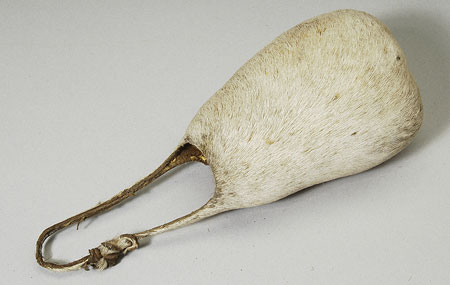Accession Number:
1931.66.20
Country:
Sudan
Region:
[Southern Sudan]
Cultural Group:
Nuer
Date Made:
By 1931
Materials:
Cattle Skin Animal
Process:
Knotted , Tied
Dimensions:
Total L/ Ht = 220; handle L = 100, handle W = 5.7, handle th = 2; body L = 120, mouth diam = 40, lower body diam = 88.5 x 78.5 mm [RTS 4/8/2005].
Weight:
29.8 g
Other Owners:
Collected by Edward Evan Evans-Pritchard either in the early part of 1930 (probably February to April), or between February and June of 1931 [CM; RTS 9/7/2004].
Field Collector:
Edward Evan Evans-Pritchard
PRM Source:
Edward Evan Evans-Pritchard
Acquired:
Donated December 1931
Collected Date:
1930 - 1931
Description:
Hide bag made from an animal's scrotum, possibly a bull or ox.
This has been cut to have 2 narrow strips that are knotted together on one side to form a loop handle that extends above the circular mouth of the vessel.
The body expands below this to reach its maximum diameter just above the slightly flattened base, which has a depression running across its centre; the body is oval in plan view.
The hide is stiff and inflexible, a mid brown colour on the inside surface (Pantone 7532C), and covered with whitish buff hair over the exterior.
The bag is complete and intact, with a weight of 29.8 grams and total length of 220 mm.
The handle is 100 mm long, 5.7 mm wide and 2 mm thick, while the body is 120 mm long, with a mouth diameter of 40 mm and a maximum body diameter of 88.5 by 78.5 mm.
This object was collected by Edward Evan Evans-Pritchard either in the period from February to April of 1930, during his first second season of fieldwork amongst the Nuer, or during his second expedition, which took place in the 'dry season' between February and June 1931. In the former, he spent around three and a half months in Leek territory at Yahnyang and Pakur on the Bahr el Ghazal, in Lou territory at Muot Dit, and at Adok, amongst the Dok Nuer. In the latter, he spent five and a half months at Nasir, on the Nyanding River, and at Yakwat on the Sobat River (see E.E. Evans-Pritchard, 1940, The Nuer, and the map of Evans-Pritchard's fieldwork in D.H. Johnson, "Evans-Pritchard, the Nuer, and the Sudan Political Service", African Affairs 81 no. 323, p. 233).
The Nuer made bags of this kind from the scrota of bulls and giraffe, and used them to hold tobacco, spoons and other small objects (E.E. Evans-Pritchard, 1940, The Nuer, p. 30 and fig. 3; the illustrated objects are in the Cambridge Museum of Archaeology and Anthropology ). The Pitt Rivers Museum has another such bag collected by Evans-Pritchard around the same time (1931.66.19). For a similar bag, used by the Shilluk, see R. Boccassino, 1966, "Contributo allo studio dell'ergologia delle popolazioni nilotiche e nilo-camitiche, parte V", Annali Lateranensi XXX , fig. 58, and p. 302 (Hamburgisches Museum für Völkerkunde und Vorgeschichte Accession number 17.28:288). The Bari also made use of animal scrota for small purses; these have flattened bodies rather than the fuller shape seen in this example (see 1934.8.42-43).
Rachael Sparks 4/8/2005.
This object was collected by Edward Evan Evans-Pritchard either in the period from February to April of 1930, during his first second season of fieldwork amongst the Nuer, or during his second expedition, which took place in the 'dry season' between February and June 1931. In the former, he spent around three and a half months in Leek territory at Yahnyang and Pakur on the Bahr el Ghazal, in Lou territory at Muot Dit, and at Adok, amongst the Dok Nuer. In the latter, he spent five and a half months at Nasir, on the Nyanding River, and at Yakwat on the Sobat River (see E.E. Evans-Pritchard, 1940, The Nuer, and the map of Evans-Pritchard's fieldwork in D.H. Johnson, "Evans-Pritchard, the Nuer, and the Sudan Political Service", African Affairs 81 no. 323, p. 233).
The Nuer made bags of this kind from the scrota of bulls and giraffe, and used them to hold tobacco, spoons and other small objects (E.E. Evans-Pritchard, 1940, The Nuer, p. 30 and fig. 3; the illustrated objects are in the Cambridge Museum of Archaeology and Anthropology ). The Pitt Rivers Museum has another such bag collected by Evans-Pritchard around the same time (1931.66.19). For a similar bag, used by the Shilluk, see R. Boccassino, 1966, "Contributo allo studio dell'ergologia delle popolazioni nilotiche e nilo-camitiche, parte V", Annali Lateranensi XXX , fig. 58, and p. 302 (Hamburgisches Museum für Völkerkunde und Vorgeschichte Accession number 17.28:288). The Bari also made use of animal scrota for small purses; these have flattened bodies rather than the fuller shape seen in this example (see 1934.8.42-43).
Rachael Sparks 4/8/2005.
Primary Documentation:
Accession Book Entry
[IX, p.
16] 1931 [insert, in pencil] 66 [end insert]
E.
EVANS-PRITCHARD
, Esq.
Dec.
Specimens collected by himself in the EASTERN SUDAN, viz.
[pencil insert, p.
18] 19-20 [end insert] - [One of] 2 bag-like receptacles with loop handles, for carrying odds & ends, made from the scrota of large animals (?ox and giraffe).
NUER.
Card Catalogue Entry - There is no further information on the tribes catalogue card [RTS 23/7/2004].
Pitt Rivers Museum label - Receptacle for odds & ends, made from the scrotum of a bull. NUER tribe, E. SUDAN. Pres. by E. Evans-Pritchard 1931 [rectangular metal-edged tag, tied to object; RTS 4/8/2005].
Card Catalogue Entry - There is no further information on the tribes catalogue card [RTS 23/7/2004].
Pitt Rivers Museum label - Receptacle for odds & ends, made from the scrotum of a bull. NUER tribe, E. SUDAN. Pres. by E. Evans-Pritchard 1931 [rectangular metal-edged tag, tied to object; RTS 4/8/2005].




